Gothic art 1400–1550
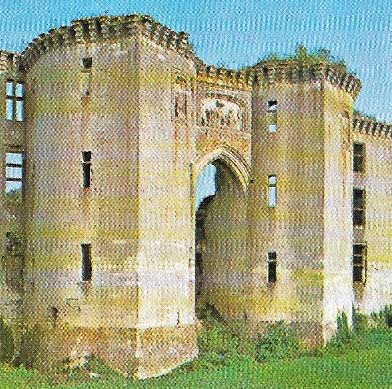
Figure 1. The ruins of the Chateau of La Ferte Millon, built for a cousin of the Duc de Berry, give some idea of how fantasy castles really looked, even though it has now lost the greater part of its ornamentation.
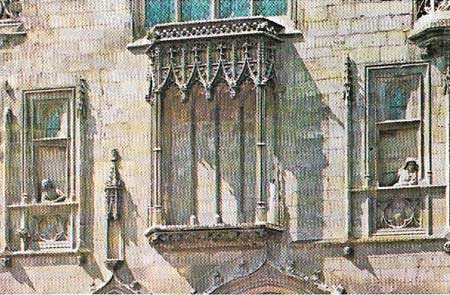
Figure 2. The house of Jacques Coeur on Bourges (mid-15th century) was also a warehouse. Coeur was an immensely successful merchant who built a small palace from which to carry on his business, he paid for the restoration of Bourges Cathedral, in return for which the pope made his son an archbishop. He took the unusual step of having himself and his wife Macee. Leaning from behind stone balconies, added to the façade of the building. It was at this time that merchants throughout Western Europe were having more influence on the arts as their purchasing power increased with wealth.
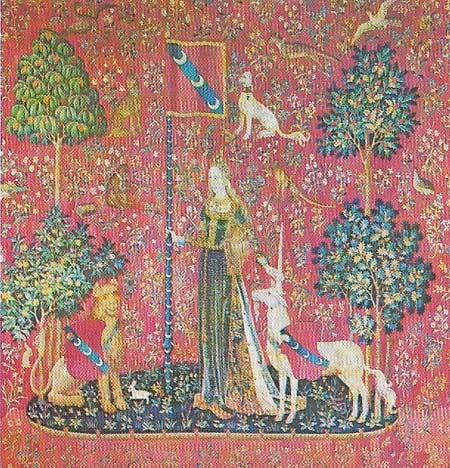
Figure 3. The six French tapestries of the "Lady with the Unicorn" in Paris, were made about 1500 for the Le Viste family and illustrate the five senses, the sense of taste is shown here.
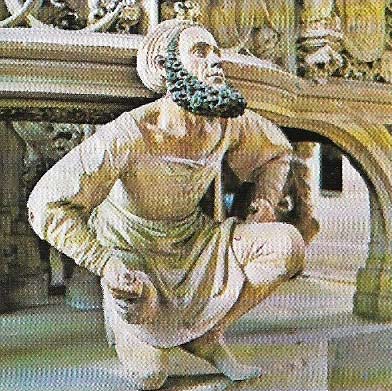
Figure 4. Little is known of medieval masons and builders, and portraits are rare. Adam Kraft (c. 1450–c. 1508) carved himself holding a mallet and chisel as one of the "Atlas" supports in the Sacrament House of the Church of St Lorenz, Nuremberg (1493). In sculpting this church he took the opportunity to invent architectural forms that did not have to bear any weight and which would writhe right up to the vault. He introduced a new restraint into late Gothic sculpture.
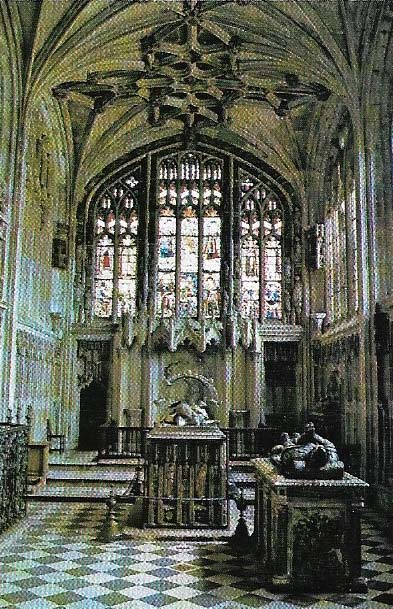
Figure 5. The Beauchamp Chapel (c. 1447) of St Mary's Church, Warwick, was a religious enterprise financed by lay patronage. No expense was spared over the sculpture of the Warwick tombs or the stained glass that fills the windows of three sides of the chapel. It includes a series of angels holding a continuous scroll of the Te Deum and magnificent figures in the east windows.
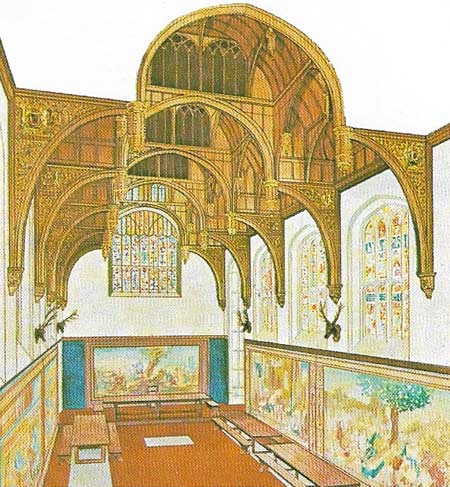
Figure 6. The Great Hall of Hampton Court Palace was built by Henry VIII in 1531–1536 after the fall of Cardinal Wolsey. As at Warwick, all details were planned together to produce a rich effect. The hammer-beam roof, with elaborate pendants, was carved by Richard Rydge of London. Armorial glass filled the windows and imported tapestries lined the walls of this domestic interior.
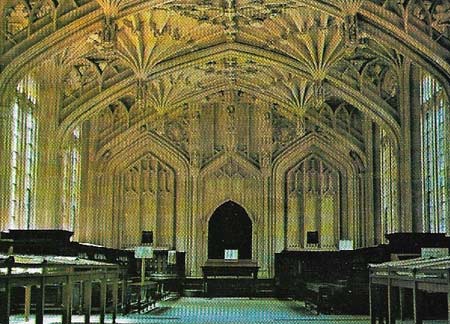
Figure 7. The cones of ribs in the vault of Oxford University Divinity School (1483) are designed to hang free as pendants. On a small scale this is the principal of the fan-vault in Henry VII's Chapel at Westminster Abbey (1503–1519). The panels of tracery "ribs" there are merely carved on the surface of the stone slabs of which the vault is constructed. This is a measure of the development of vaulting - that the load-bearers could be treated as ornament.
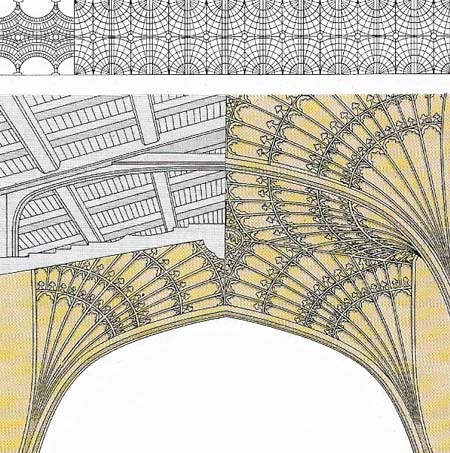
Figure 8. The fan-vault, King's College, Cambridge (1508–1515), by John Wastell, uses applied tracery as at Gloucester. The effect is delicate and contrived even on this scale.
Art in Europe during the late Middle Ages can be seen as a further development of the International Gothic style. Delight in things colorful, courtly and complex is found in all branches of art and architecture, although obviously there are regional variations.
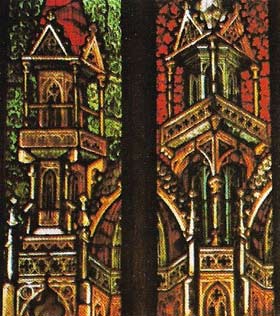 |
| In St Stephen's Vienna, the architectural canopies above figures of the Hapsburg emperors were designed c. 1400 as a three-light unit with convincing perspective to give an illusion of depth. |
Gothic art and patronage
In Italy the love of Gothic decoration and rich materials persisted in the work of Gentile da Fabriano (c. 1370–c. 1427) and Benozzo Gozzoli (c. 1420–1497). In the north of Europe, International Gothic had no rival. On the whole, there was a redoubling of decorative detail in parallel with increasing realism. For example, the animals, birds and plants that surround the principal figures in the tapestries of the "Lady with the Unicorn" (Figure 3) stand out in lifelike detail. This is probably helped by the novel use of red instead of the usual blue for the ground. As a result, blue and green could be used for modelling without spoiling the overall effect.
Almost everywhere, panel paintings are known to have been a popular art form for use as altarpieces, but few have survived other than Flemish or German ones. In contrast, illuminated manuscripts have suffered much less. Books of Hours seem to have been extremely popular. These were service-books for wealthy laymen, and especially for ladies, and they appear to have been objects of prestige and pleasure. The Bedford Hours, for example, was given to King Henry VI for Christmas when he was a boy.
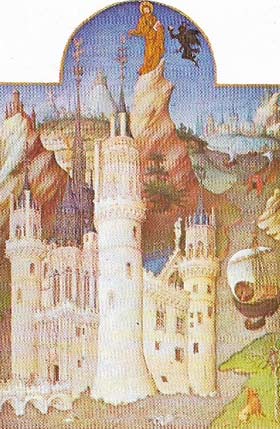 |
| Mehun-sur-Yevre, the favorite castle of the Duc de Berry, was made even more fantastical in this illustration to his manuscript, the Tres Riches Heures, by the Limbourgs, than it was in reality. |
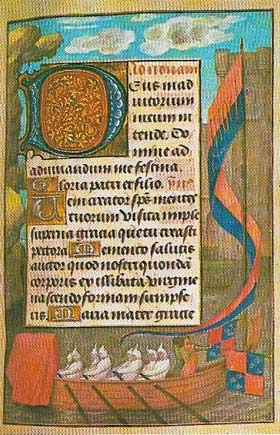 |
| The Hastings Hours (c. 1480), which includes a portrait of Edward V, contains detailed studies of wild and garden flowers and this picture of the royal barge on the River Thames. |
By no means all patronage came from the aristocracy, however; the "Lady with the Unicorn" tapestries were commissioned by a family of the high bourgeoisie rather than of the nobility. The patronage of this section of society was extremely important during the period. Many outstanding English manor houses were owned by merchants; for example, Hever Castle in Kent was bought by Sir Geoffrey Boleyn, a mercer, in 1462. The house of Jacques Coeur in Bourges (Figure 2) is a French example of property being accumulated by the merchant classes. Merchants founded charitable institutions like Browne's Hospital in Stamford, Lincolnshire (around 1490). They also financed the building of many great "wool-churches" in East Anglia. In Europe generally, and especially in central Europe, this was the great age of the parish church, paid for by the local trading community but often built on a cathedral scale.
Late Gothic architecture
In Europe, late Gothic architecture tends towards the exotic. For the French version, with its flame-like tracery rippling over walls as well as in windows, the term "flamboyant" is appropriately used. Examples can be seen at Rouen (St Maclou), Caudebec in Normandy and Notre Dame de l'Epine near Nancy. In the Iberian Peninsula plant-like decoration was popular. In Germany and Bohemia architects became adept at designing ingenious new patterns for vaults. Net-vaults were extremely popular. Instead of the ribs splaying out from the supports and crossing each other at various angles, the whole area was covered by a fretwork of parallel ribs. Sometimes nave and aisles are treated together; at other there is a different pattern for each area, and at Nordlingen in Bavaria there are three distinct patterns for the nave alone.
An alternative to the net-vault is to make the ribs curve sinuously across the surface of the vault. This makes flower-like effects as at Wasserburg in Germany, and invites such excesses as making the rib appear to jump diagonally across the space of a window, as at Kutna Hora in Czechoslovakia.
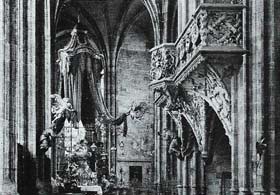 |
| The Royal Pew in St Vitus' Cathedral, Prague, demonstrates a different illusionism from that of the Church of St Lorenz. At Prague the normal stone rib construction is carved to imitate wood with its knots and forks. Benedict Reid's Vladislav Hall (1487–1502) and stairs in Hradcany Castle nearby have ribs that intersect and overshoot each other as if they were single branches. |
Similar artistry was lavished on the small structures that make up church furnishings: fonts, pulpits and especially containers for the sacrament. These architectural motifs were repeated in the stained glass, which was often provided to add color to the interiors (Figure 5), and especially in the wooden altarpieces, which are such outstanding works of art of the period. Tilman Riemenschneider and Veit Stoss are justifiably the most famous carvers and sculptors of this period: their figures are so lifelike as to appear portraits, yet they are stylized in order to fit naturally into the narrative subjects.
English architecture
English architects created a style known as Perpendicular, lavishing their efforts on vaults, with elaborate wooden angel-roofs as a substitute in smaller structures. Many vaults are variations of the lierne design (a system of smaller connecting ribs) of Canterbury: for instance, York Minster choir (c. 1400). Others like Bath Abbey, Sherborne Abbey (c. 1430–c. 1500 in stages), St George's Chapel, Windsor (begun 1481), and Henry VII's Chapel at Westminster, develop the idea of "fan" vaults (Figure 8) first initiated in the cloister at Gloucester during the previous century.
In the late Gothic period, windows generally became larger and included brilliant displays of stained glass. But in most decorative forms of the 15th century there is less variety than in the 14th, a trend that led, for example, to numerous instances of the same cartoon being used for stained glass in different churches. An example is the figure of St John the Evangelist in Sherborne Almshouse, Dorset, which is repeated at East Brent in Somerset. Such repetition, both in art and architecture, reduced the original freshness and inventiveness of the Gothic style, permitting a readier acceptance of the Renaissance in northern Europe.
